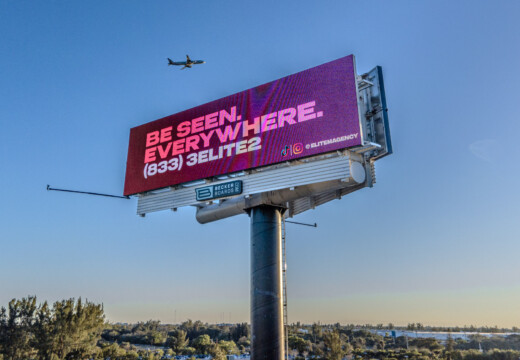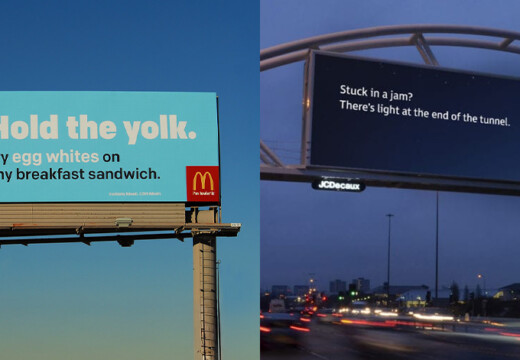Digital billboards are now an affordable and flexible marketing tool for small businesses. They let you advertise locally, update messages instantly, and control costs with pay-as-you-go models. Here’s how to make the most of them:
- Pick the Right Locations: Choose high-traffic spots where your audience is most likely to see your ads.
- Schedule Smartly: Run ads during peak hours for visibility or off-peak times to save money.
- Design Eye-Catching Ads: Keep messages short, use bold visuals, and ensure readability at a glance.
- Target Locally: Focus on specific areas or events to connect with your community.
- Integrate with Social Media: Use billboards to drive engagement online with hashtags, QR codes, or promotions.
With real-time updates and precise targeting, digital billboards help small businesses reach the right audience without overspending.
Digital Billboard Brand Marketing Strategy
1. Pick the Best Billboard Locations
Choosing the right billboard locations can make or break your advertising efforts. To get the most out of your campaign, focus on spots that combine strong audience reach with excellent visibility.
Find Out Where Your Customers Go
Start by using tools like Google Maps or traffic reports to track where your target audience spends time. Look for areas with heavy foot or vehicle traffic, such as shopping centers, busy intersections, or business districts that match your audience’s habits and interests.
Assess Billboard Placement Quality
Not all billboard spots are created equal. Look for locations with the right viewing distance, long exposure time, and minimal distractions. The goal is to ensure your billboard grabs attention and stands out from the clutter. For example, Blip’s platform can help you evaluate these factors and choose locations that maximize your ad’s visibility .
Pay attention to details like billboard height, angle, lighting, and any potential obstacles (like trees or buildings) that could block your ad. It’s also important to consider if the surrounding environment – like nearby office buildings or retail hubs – aligns with your target audience’s behavior.
Blip’s platform makes it easier for small businesses to test and adjust billboard placements without locking into long-term contracts. This flexibility allows businesses to focus on smart, budget-friendly choices that deliver results.
Once you’ve nailed down the perfect locations, the next step is fine-tuning your ad schedule to ensure your message gets seen at the right times.
2. Schedule Ads at the Right Times
For small businesses working with tight budgets, timing your ads effectively ensures your money is spent wisely. Digital billboard platforms let you control when your ads appear, helping you boost visibility while keeping costs in check.
Focus on Peak Hours
Display your ads during busy times like the Morning Rush (7 AM – 9 AM), Lunch Break (11 AM – 2 PM), or Evening Commute (4 PM – 7 PM). Use local traffic data to pinpoint when your audience is most likely to notice your ads.
Many digital billboard platforms also provide analytics that highlight the busiest hours for specific locations. This data helps you target your audience when it matters most.
Take Advantage of Off-Peak Pricing
Off-peak hours often come with lower rates, giving small businesses the chance to stretch their budget, experiment with different messages, and stay visible without overspending. For example, a local gym could run ads in the early morning (5 AM – 7 AM) when rates are lower but still reach their core audience – early risers looking to work out.
Here’s a quick breakdown of how to align your ad schedule with your goals:
| Time Period | Traffic Level | Pricing | Best For |
|---|---|---|---|
| Peak Hours | High | Premium | Promotions with deadlines |
| Shoulder Hours | Medium | Standard | Building brand awareness |
| Off-Peak | Low | Discounted | Testing campaigns or saving |
Once your timing is set, the next step is creating designs that grab attention and leave a lasting impression.
sbb-itb-2e2e93f
3. Create Clear, Eye-Catching Ads
With only a few seconds to grab attention, every part of your ad needs to work together to make an impact and get your message across.
Keep Messages Short and Clear
Your message should be easy to understand at a glance. Stick to one main idea and use bold, large fonts that are readable from far away.
Here’s a simple structure you can follow for a digital billboard:
| Element | Guidelines | Example |
|---|---|---|
| Headline | 3-5 words max | "Half-Price Pizza Tuesday" |
| Supporting Text | Up to 7 words | "Main St, 4-8 PM" |
| Visual Elements | 1 strong image | Single product shot or logo |
| Call-to-Action | 2-3 words | "Order Now: 555-0123" |
High contrast between text and background colors is crucial. For instance, bright yellow text on a dark background can improve visibility by 40% compared to low-contrast designs .
Add Movement to Stand Out
Adding animation can make your ad more engaging, but it should always support your message without becoming distracting. Keep these tips in mind:
- Use subtle fades or slides instead of flashy effects.
- Limit animations to 10 seconds so viewers have time to take in your message.
- Make sure text stays on screen long enough to be read fully.
For an extra edge, include real-time elements. For example, a coffee shop might display the current temperature alongside a promotion for hot or iced drinks. This makes the ad feel more relevant to what viewers care about in the moment .
Finally, test your animations from different distances and angles to ensure they’re effective. Studies show that simple animations can increase viewer retention by 25% compared to static ads .
Once your ad design is polished, it’s time to focus on reaching the right audience.
4. Target Local Audiences Precisely
Digital billboard advertising becomes far more effective when you zero in on specific geographic areas. Modern targeting tools let you deliver timely, relevant messages to the right audience. Combine this precision with eye-catching designs, and your ads are set to make an impact.
Set Up Location-Based Targeting
Small businesses can focus on neighborhoods, zip codes, or even competitor hotspots to make their ads more relevant and impactful.
Here are some targeting strategies to consider:
| Targeting Strategy | How It Works | Example Use Case |
|---|---|---|
| Radius Targeting | Define a 1-5 mile radius around your location | A coffee shop targeting morning commuters within 2 miles |
| Route Targeting | Focus on major roads leading to your business | A restaurant targeting evening traffic on Main Street |
| Competitor Targeting | Place ads near competitor locations | A car dealership advertising near rival dealerships |
| Event Targeting | Target venues during specific events | A sports bar promoting specials near a stadium on game days |
Traffic patterns play a big role in billboard success. A sign on a busy commuter route can reach thousands during rush hour. Plus, dynamic pricing models let you save money by targeting less busy times .
Match Ads to Local Events
Tying your ads to local happenings can help you connect with the community and drive engagement.
- Weather-based messaging: Promote hot drinks on chilly days or ice cream during a heatwave.
- Sports schedules: Tailor your ads for before and after local games.
- Community events: Highlight offers tied to festivals, farmers markets, or seasonal celebrations.
Real-time campaign tools let you adapt quickly to changing conditions. For example, a hardware store could promote umbrellas and rain gear during an unexpected rainstorm .
To get the most out of location-based targeting, study foot traffic patterns and consumer habits in your chosen areas. This data helps you fine-tune your messaging and timing for better results . Keep an eye on metrics like store visits and sales to measure how well your campaigns are working.
Once your targeting is on point, the next step is to expand your campaign’s reach by integrating your billboard ads with social media.
5. Connect Billboards with Social Media
Combining digital billboards with social media is a smart way for small businesses to expand their reach and engage local audiences. By linking these channels, you can create a stronger, more unified brand presence and amplify your advertising efforts.
Encourage Social Media Engagement
Turn your billboard into a tool for social media interaction by including clear calls to action. Here are a few ideas:
| Campaign Type | Action Prompt | Expected Outcome |
|---|---|---|
| Photo Contest | "Scan the QR Code and enter with #ContestName" | More user-generated content |
| Event Promotion | "Post your event photos with #EventName" | Increased event participation |
| Special Offers | "Use this code for 20% off: BILLBOARD20" | Trackable sales conversions |
| Community Challenge | "Join us: #LocalChallenge" | Boosted local engagement |
For example, a message like "Snap a photo and tag us with #LocalEats" can encourage people to interact with your brand and share their experiences.
Align Your Messaging
Consistency is key to building brand recognition. Here’s how to stay aligned:
- Visuals and Hashtags: Use the same logos, colors, fonts, and hashtags across your billboards and social media.
- Multi-Channel Sharing: Post your billboard content on your social platforms to reinforce your message.
- Timing: Sync your social media posts with your billboard display schedules for maximum impact.
"If you create unique content for these channels specifically to cross promote on social media, that’s where the power of this technique resides."
To measure success, track hashtag usage, monitor follower growth, and review engagement metrics on platforms like Instagram and Twitter. You can also use unique QR codes or URLs on your billboards to see how much traffic your outdoor ads are driving to your social media pages .
Conclusion: Start Your Digital Billboard Campaign
Key Takeaways
To succeed with digital billboards, focus on high-traffic locations, smart ad scheduling, bold and concise designs, local targeting, and social media integration. The rise of pay-per-play pricing – starting as low as $0.01 per display – has made this advertising channel more accessible for small businesses.
| Strategy | Tips for Success | Results You Can Expect |
|---|---|---|
| Location Selection | Choose areas with heavy foot or vehicle traffic | Greater visibility for your audience |
| Ad Scheduling | Combine peak times with lower-cost off-peak slots | Smarter use of your budget |
| Creative Design | Use fewer than 8 words and bold visuals | Higher engagement and better recall |
| Local Targeting | Target specific neighborhoods or postcodes | Stronger local customer response |
| Social Integration | Add trackable calls-to-action | Clearer insights and measurable results |
With these steps, starting your campaign is straightforward and effective.
Getting Started
- Set Your Budget and Locations: Decide on your spending limits and focus areas that align with your goals and audience.
- Create Your Ad: Design a simple, attention-grabbing ad. Research shows that clear and concise messaging leads to better engagement and recall .
- Launch and Track: Use real-time tools to monitor performance. Keep an eye on metrics like impressions and engagement rates to fine-tune your campaign for better results.


